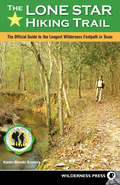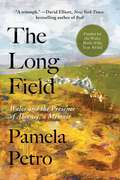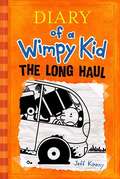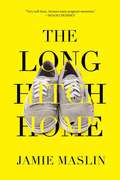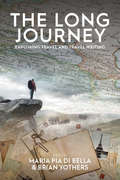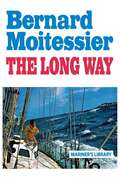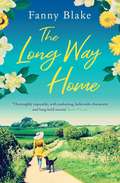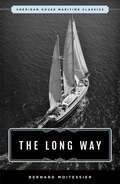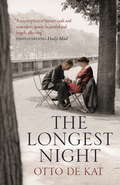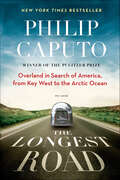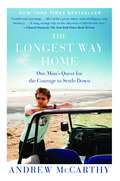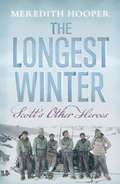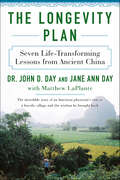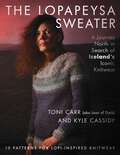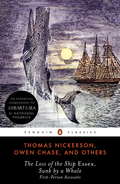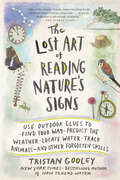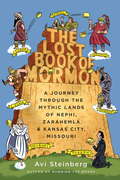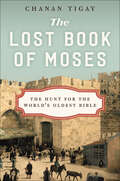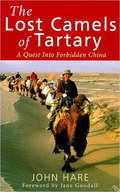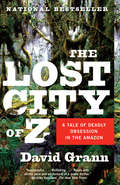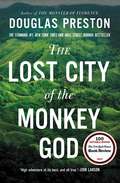- Table View
- List View
The Lone Star Hiking Trail
by Karen SomersOne of the hidden jewels of Texas, the Lone Star Hiking Trail is the only long-distance National Recreation Trail in the state. At 128 miles (including loop trails), it is also the state's longest continuously marked and maintained footpath. Located in the famed Big Thicket area in east Texas, the trail is well-suited for both short and long hikes (of up to 10 days), appealing to dayhikers, overnight backpackers and long-distance hikers. The LSHT lies between the major metro centers of Houston-Galveston, Dallas-Fort Worth, Austin, and San Antonio--home to more than 8 million people just a 2-hour drive from the trail. The author, a Texas native, is an experienced long-distance hiker who has thru-hiked the Appalachian Trail, the Pacific Crest Trail, and many other nationally recognized long-distance trails throughout the U.S. This is the first guidebook to the trail and is officially endorsed and promoted by the Lone Star Hiking Trail Club.
The Long Field: Wales and the Presence of Absence, a Memoir
by Pamela PetroFor readers of H Is for Hawk, an intimate memoir of belonging and loss and a mesmerizing travelogue through the landscapes and language of WalesHiraeth is a Welsh word that's famously hard to translate. Literally, it can mean "long field" but generally translates into English, inadequately, as "homesickness." At heart, hiraeth suggests something like a bone-deep longing for an irretrievable place, person, or time—an acute awareness of the presence of absence. In The Long Field, Pamela Petro braids essential hiraeth stories of Wales with tales from her own life—as an American who found an ancient home in Wales, as a gay woman, as the survivor of a terrible AMTRAK train crash, and as the daughter of a parent with dementia. Through the pull and tangle of these stories and her travels throughout Wales, hiraeth takes on radical new meanings. There is traditional hiraeth of place and home, but also queer hiraeth; and hiraeth triggered by technology, immigration, ecological crises, and our new divisive politics. On this journey, the notion begins to morph from a uniquely Welsh experience to a universal human condition, from deep longing to the creative responses to loss that Petro sees as the genius of Welsh culture. It becomes a tool to understand ourselves in our time. A finalist for the Wales Book of the Year Award and named to the Telegraph's and Financial Times's Top 10 lists for travel writing, The Long Field is an unforgettable exploration of &“the hidden contours of the human heart.&”
The Long Haul (Diary of a Wimpy Kid #9)
by Jeff KinneyA family road trip is supposed to be a lot of fun . . . unless, of course, you’re the Heffleys. The journey starts off full of promise, then quickly takes several wrong turns. Gas station bathrooms, crazed seagulls, a fender bender, and a runaway pig—not exactly Greg Heffley’s idea of a good time. But even the worst road trip can turn into an adventure—and this is one the Heffleys won’t soon forget.
The Long Haul (The Diary of a Wimpy Kid #9)
by Jeff KinneyA family road trip is supposed to be a lot of fun . . . unless, of course, you're the Heffleys. <P><P>The journey starts off full of promise, then quickly takes several wrong turns. Gas station bathrooms, crazed seagulls, a fender bender, and a runaway pig--not exactly Greg Heffley's idea of a good time. But even the worst road trip can turn into an adventure--and this is one the Heffleys won't soon forget.
The Long Hitch Home
by Jamie MaslinTasmania to London. 800 hitchhiking trips. One year. Intrepid traveler and author Jamie Maslin does it again as he undertakes one of the most grueling, enlightening, and hilarious journeys of his life.How many rides does it take to hitch from Tasmania to London? Intrepid traveler and rogue wanderer Jamie Maslin decides to find out. The Long Hitch Home is a vibrant travelog of well-researched social, cultural, and historical introductions to the score of countries Maslin passed through.Whether writing about the exotic backstreets of cities few of us will get to see firsthand, or the unique geographical wonders of far off countries, Jamie Maslin gives a thrilling account of what it is like to hit the road and live with intensity and rapture.
The Long Journey: Exploring Travel and Travel Writing
by Maria Pia Di Bella and Brian YothersTravel writing has, for centuries, composed an essential historical record and wide-ranging literary form, reflecting the rich diversity of travel as a social and cultural practice, metaphorical process, and driver of globalization. This interdisciplinary volume brings together anthropologists, literary scholars, social historians, and other scholars to illuminate travel writing in all its forms. With studies ranging from colonial adventurism to the legacies of the Holocaust, The Long Journey offers a unique dual focus on experience and genre as it applies to three key realms: memory and trauma, confrontations with the Other, and the cultivation of cultural perspective.
The Long Way
by Bernard MoitessierThe Long Way is Bernard Moitessier's own incredible story of his participation in the first Golden Globe Race, a solo, non-stop circumnavigation rounding the three great Capes of Good Hope, Leeuwin, and the Horn. For seven months, the veteran seafarer battled storms, doldrums, gear-failures, knock-downs, as well as overwhelming fatigue and loneliness. Then, nearing the finish, Moitessier pulled out of the race and sailed on for another three months before ending his 37,455-mile journey in Tahiti. Not once had he touched land.
The Long Way Home: the perfect staycation summer read
by Fanny BlakeA family secret, a mysterious legacy, and a journey that will change everything… When Isla, a 65-year-old grandmother, is left nothing but an old painting in her mother&’s will, while her sisters and aunt inherit the estate, she is devastated. Close to retirement, getting ready to live on her own terms, the last thing she expects at this time of her life is such turmoil. So, to find an explanation for her mother&’s rejection, she embarks on a road-trip. But, right at the last moment, she&’s forced to take her sullen – and, in her view, impossible – 14-year-old granddaughter Charlie with her. Cramped together in Isla&’s car with her smelly old dog, these ill-assorted travelling companions set off to uncover some shattering and life-changing family truths at the same time as learning to love each other… The Long Way Home is set in the UK and 1950s Paris where the story really begins, spanning four generations of women and the secrets that get passed down through them.Praise for Fanny Blake's novels: &‘No-one does family and friendship better than Fanny . . . Warm, funny, wise and relatable&’ Veronica Henry &‘Loved it . . . a beautiful story of coming back to life in middle age, full of love, joy and hope&’ Liz Fenwick &‘A hopeful, warm, generous-hearted novel about how love transcends difference&’ Julie Cohen 'A warm, uplifting read' Rosanna Ley 'The plot reels you in until you have no choice but to devour every word' heat 'Absorbing, intelligent and an absolute joy to read' Daily Express 'A fantastic read from one of our favourite authors' Bella
The Long Way Westward
by Joan SandinThis book describes the experiences of two young brothers and their family who are immigrants from Sweden, from their arrival in New York through the journey to their new home in Minnesota.
The Long Way: Sheridan House Maritime Classic (Maritime Classics)
by Bernard MoitessierThe Long Way is Bernard Moitessier's own incredible story of his participation in the first Golden Globe Race, a solo, non-stop circumnavigation rounding the three great Capes of Good Hope, Leeuwin, and the Horn. For seven months, the veteran seafarer battled storms, doldrums, gear-failures, knock-downs, as well as overwhelming fatigue and loneliness. Then, nearing the finish, Moitessier pulled out of the race and sailed on for another three months before ending his 37,455-mile journey in Tahiti. Not once had he touched land.
The Longest Night
by Otto de KatA masterpiece of literary craft and concision; sparse, beautiful and hugely affecting - Daily MailSince the liberation of the Netherlands, Emma Verweij has been living in Rotterdam, in a street which became a stronghold of friendships for its inhabitants during the Second World War. She marries Bruno, they have two sons, and she determines to block out the years she spent in Nazi Berlin during the war, with her first husband Carl. But now, ninety-six years old and on the eve of her death, long- forgotten memories crowd again into her consciousness, flashbacks of happier years, and the tragedy of the war, of Carl, of her father, and of the friends she has lost. In The Longest Night, his impressive, reflective new novel after News from Berlin, Otto de Kat deftly distils momentous events of 20th-century history into the lives of his characters. In Emma, the past and the present coincide in limpid fragments of rare, melancholy beauty.Translated from the Dutch by Laura Watkinson
The Longest Night
by Otto de KatA masterpiece of literary craft and concision; sparse, beautiful and hugely affecting - Daily MailSince the liberation of the Netherlands, Emma Verweij has been living in Rotterdam, in a street which became a stronghold of friendships for its inhabitants during the Second World War. She marries Bruno, they have two sons, and she determines to block out the years she spent in Nazi Berlin during the war, with her first husband Carl. But now, ninety-six years old and on the eve of her death, long- forgotten memories crowd again into her consciousness, flashbacks of happier years, and the tragedy of the war, of Carl, of her father, and of the friends she has lost. In The Longest Night, his impressive, reflective new novel after News from Berlin, Otto de Kat deftly distils momentous events of 20th-century history into the lives of his characters. In Emma, the past and the present coincide in limpid fragments of rare, melancholy beauty.Translated from the Dutch by Laura Watkinson
The Longest Road: Overland in Search of America, from Key West to the Arctic Ocean
by Philip CaputoIn The Longest Road, one of America's most respected writers takes an epic journey across America, Airstream in tow, and asks everyday Americans what unites and divides a country as endlessly diverse as it is large.Standing on a wind-scoured island off the Alaskan coast, Philip Caputo marveled that its Inupiat Eskimo schoolchildren pledge allegiance to the same flag as the children of Cuban immigrants in Key West, six thousand miles away. And a question began to take shape: How does the United States, peopled by every race on earth, remain united? Caputo resolved that one day he'd drive from the nation's southernmost point to the northernmost point reachable by road, talking to everyday Americans about their lives and asking how they would answer his question.So it was that in 2011, in an America more divided than in living memory, Caputo, his wife, and their two English setters made their way in a truck and classic trailer (hereafter known as "Fred" and "Ethel") from Key West, Florida, to Deadhorse, Alaska, covering 16,000 miles. He spoke to everyone from a West Virginia couple saving souls to a Native American shaman and taco entrepreneur. What he found is a story that will entertain and inspire readers as much as it informs them about the state of today's United States, the glue that holds us all together, and the conflicts that could cause us to pull apart.
The Longest Way Home: One Man's Quest for the Courage to Settle Down
by Andrew MccarthyWITH AN IRREPRESSIBLE TASTE for adventure, candor, and a vivid sense of place, award-winning travel writer and actor Andrew McCarthy takes us on a deeply personal journey played out amid some of the world's most evocative locales. Unable to commit to his fiancÉe of nearly four years--and with no clear understanding of what's holding him back--Andrew McCarthy finds himself at a crossroads, plagued by doubts that have clung to him for a lifetime. Something in his character has kept him always at a distance, preventing him from giving himself wholeheartedly to the woman he loves and from becoming the father that he knows his children deserve. So before he loses everything he cares about, Andrew sets out to look for answers. Hobbling up the treacherous slopes of Mt. Kilimanjaro, dodging gregarious passengers aboard an Amazonian riverboat, and trudging through dense Costa Rican rain forests--Andrew takes us on exotic trips to some of the world's most beautiful places, but his real journey is one of the spirit. On his soul-searching voyages, Andrew traces the path from his New Jersey roots, where acting saved his life--and early fame almost took it away--to his transformation into a leading travel writer. He faces the real costs of his early success and lays bare the evolving nature of his relationships with women. He explores a strained bond with his father, and how this complex dynamic shapes his own identity as a parent. Andrew charts his journey from ambivalence to confidence, from infidelity and recklessness to acceptance and a deeper understanding of the internal conflicts of his life. A gifted writer with an unsparing eye, Andrew relishes bizarre encounters with the characters whom he encounters, allowing them to challenge him in unexpected ways. He gets into peculiar, even dangerous situations that put him to the test--with mixed results. Disarmingly likable, Andrew is open, honest, and authentic on every page, and what emerges is an intimate memoir of self-discovery and an unforgettable love song to the woman who would be his wife.
The Longest Winter: Scott's Other Heroes
by Meredith HooperThrough the eyes of the men involved, Meredith Hooper recounts one of the greatest tales of adventure and endurance, which has often been overshadowed by the tragedy that befell Scott.Their tents were torn, their food was nearly finished, and the ship had failed to pick them up as planned. Gale-force winds blew, bitter with the cold of approaching winter. Stranded and desperate, Lieutenant Victor Campbell and his five companions faced disaster. They burrowed inside a snowdrift, digging an ice-cave with no room to stand upright, but space for six sleeping bags on the floor-the three officers on one side, the tree seamen on the other. Circumstances forced them closer together, their roles blurred, and a shared sense of reality emerged. This mutual suffering made them indivisible and somehow they made it through the longest winter.To the south, the men waiting at headquarters knew that Scott and his Polar party must be dead and hoped that another six lives would not be added to the death toll. Working from diaries, journals, and letters written by expedition members, Meredith Hooper tells the intensely human story of Scott's other expedition.
The Longevity Plan: Seven Life-Transforming Lessons from Ancient China
by Jane Ann Day John D. Day Matthew LaPlanteFrom a renowned Johns Hopkins- and Stanford-educated cardiologist at Intermountain Medical Center—a hospital system that President Obama has praised as an "island of excellence"—comes the story of his time living in Longevity Village in China, and the seven lessons he learned there that lead to a happy, healthy, long lifeAt forty-four, acclaimed cardiologist John Day was overweight and suffered from insomnia, degenerative joint disease, high blood pressure, and high cholesterol. On six medications and suffering constant aches, he needed to make a change. While lecturing in China, he’d heard about a remote mountainous region known as Longevity Village, a wellness Shangri-La free of heart disease, cancer, diabetes, obesity, dementia, depression, and insomnia, and where living past one hundred—in good health—is not uncommon.In the hope of understanding this incredible phenomenon, Day, a Mandarin speaker, decided to spend some time living in Longevity Village. He learned everything he could about this place and its people, and met its centenarians. His research revealed seven principles that work in tandem to create health, happiness, and longevity—rules he applied to his own life. Six months later, he’d lost thirty pounds, dropped one hundred points off his cholesterol and twenty-five points off his blood pressure, and was even cured of his acid reflux and insomnia. In 2014 he began a series of four-month support groups comprised of patients who worked together to apply the lessons of Longevity Village to their lives. Ninety-two percent of the participants were able to adhere to their plans and stay on pace to reach their health goals.Now Dr. Day shares his story and proven program to help you feel sharper, more motivated, productive, and pain-free. The Longevity Plan is not only a fascinating travelogue but also a practical, accessible, and groundbreaking guide to a better life.
The Lopapeysa Sweater: A Journey North in Search of Iceland's Iconic Knitwear
by Toni CarrEmbark on a journey through Iceland&’s most gorgeous landscapes and intimate traditions—straight from your armchair. The lopapeysa sweater is a treasured piece of Icelandic culture, knitted for generations, always gifted, never bought, with warmth and love in every stitch. From the breathtaking scenery, to the deep-rooted history, to the wisdom of the locals; Joan of Dark and Kyle Cassidywill be your guides as you read and knit your way through Iceland&’s culture, creativity, and lopapeysa tradition.In this knitter's guide to Iceland, join Joan and Kyle as they travel the 800 miles of Iceland&’s Ring Road to bring you historic sweaters, exciting adventures, and new knitting patterns. By interviewing local experts and digging through archives, they trace the historic beginnings of the &“lopi&” sweater and its legacy—and, of course, provide 12 new, original lopi-style patterns ranging from novice to advanced. No matter your knitting experience, you will be able to knit your way through these projects and enhance your look with style that is beautifully modern while still honoring the lopapeysa&’s rich history. We hope that this book will inspire you to visit Iceland with someone you love.
The Loss Of The Ship Essex, Sunk By A Whale
by Nathaniel Philbrick Thomas Philbrick Thomas Nickerson Owen ChaseThe gripping first-hand narrative of the whaling ship disaster that inspired Melville’s Moby-Dick and informed Nathaniel Philbrick’s monumental history, In the Heart of the Sea. In 1820, the Nantucket whaleship Essex was rammed by an angry sperm whale thousands of miles from home in the South Pacific. The Essex sank, leaving twenty crew members drifting in three small open boats for ninety days. Through drastic measures, eight men survived to reveal this astonishing tale. The Narrative of the Wreck of the Whaleship Essex, by Owen Chase, has long been the essential account of the Essex’s doomed voyage. But in 1980, a new account of the disaster was discovered, penned late in life by Thomas Nickerson, who had been the fifteen-year-old cabin boy of the ship. This discovery has vastly expanded and clarified the history of an event as grandiose in its time as the Titanic. This edition presents Nickerson’s never-before-published chronicle alongside Chase’s version. Also included are the most important other contemporary accounts of the incident, Melville’s notes in his copy of the Chase narrative, and journal entries by Emerson and Thoreau. .
The Lost Art of Reading Nature's Signs: Use Outdoor Clues To Find Your Way, Predict The Weather, Locate Water, Track Animals--and Other Forgotten Skills (Natural Navigation #0)
by Tristan GooleyTurn every walk into a game of detection—from master outdoorsman Tristan Gooley, New York Times-bestselling author of How to Read a Tree and The Natural Navigator When writer and navigator Tristan Gooley journeys outside, he sees a natural world filled with clues. The roots of a tree indicate the sun’s direction; the Big Dipper tells the time; a passing butterfly hints at the weather; a sand dune reveals prevailing wind; the scent of cinnamon suggests altitude; a budding flower points south. To help you understand nature as he does, Gooley shares more than 850 tips for forecasting, tracking, and more, gathered from decades spent walking the landscape around his home and around the world. Whether you’re walking in the country or city, along a coastline, or by night, this is the ultimate resource on what the land, sun, moon, stars, plants, animals, and clouds can reveal—if you only know how to look! #1 Bestseller in Star Gazing Publisher’s Note: The Lost Art of Reading Nature’s Signs was previously published in the UK under the title The Walker’s Guide to Outdoor Clues and Signs.
The Lost Book of Mormon
by Avi SteinbergIs the Book of Mormon the Great American Novel? Decades before Melville and Twain composed their great works, a farmhand and child seer named Joseph Smith unearthed a long-buried book from a haunted hill in western New York State that told of an epic history of ancient America, a story about a family that fled biblical Jerusalem and took a boat to the New World. Using his prophetic gift, Joseph translated the mysterious book into English and published it under the title The Book of Mormon. The book caused an immediate sensation, sparking anger and violence, boycotts and jealousy, curiosity and wonder, and launched Joseph on a wild, decades-long adventure across the American West. Today The Book of Mormon, one of the most widely circulating works of American literature, continues to cause controversy--which is why most of us know very little about the story it tells. Avi Steinberg wants to change that. A fascinated nonbeliever, Steinberg spent a year and a half on a personal quest, traveling the path laid out by Joseph's epic. Starting in Jerusalem, where The Book of Mormon opens with a bloody murder, Steinberg continued to the ruined Maya cities of Central America--the setting for most of the The Book of Mormon's ancient story--where he gallivanted with a boisterous bus tour of believers exploring Maya archaeological sites for evidence. From there the journey took him to upstate New York, where he participated in the true Book of Mormon musical, the annual Hill Cumorah Pageant. And finally Steinberg arrived at the center of the American continent, Jackson County, Missouri, the spot Smith identified as none other than the site of the Garden of Eden.Threaded through this quirky travelogue is an argument for taking The Book of Mormon seriously as a work of American imagination. Literate and funny, personal and provocative, the genre-bending The Lost Book of Mormon boldly explores our deeply human impulse to write bibles and discovers the abiding power of story.From the Hardcover edition. about us. And also an answer to the question: Why are we so afraid of the Book of Mormon? Literate and funny, personal and provocative, the genre-bending Lost Book of Mormon boldly explores our deeply human impulse to write bibles and discovers the abiding power of story.
The Lost Book of Moses: The Hunt for the World's Oldest Bible
by Chanan TigayA gripping account of one man’s quest to find the world’s oldest Bible and learn about the brilliant, doomed antiquities dealer accused of forging it.In 1883, Moses Wilhelm Shapira—archaeological treasure hunter, inveterate social climber, and denizen of Jerusalem’s bustling marketplace—arrived unannounced in London claiming to have discovered the world’s oldest Bible scroll in a desert cave east of the Dead Sea. With his phenomenal find, Shapira swiftly became world famous—but, just as quickly, his scroll was discredited as a clever forgery. With the discovery of the eerily similar Dead Sea Scrolls in 1947, however, investigators reopened the case, wondering whether Shapira had, in fact, discovered the first Dead Sea Scroll, seven decades before the rest. Here, in a globetrotting narrative with all the suspense of a classic detective story, award-winning journalist Chanan Tigay sets out to find the scrolls and determine Shapira’s guilt or innocence for himself.
The Lost Camels Of Tartary: A Quest into Forbidden China
by John HareJohn Hare has made three expeditions to the Mongolian and Chinese Gobi deserts, the first in 1993 with Russian scientists and the second and third with Chinese scientists in 1995 and 1996. The book records the amazing adventures he has experienced on those expeditions and will record details of the 30-day walk on foot in the formidable Kum Tagh sand dunes in the spring of 1997. He is the first recorded foreigner to have crossed the Gashun Gobi from north to south. The expeditions were primarily concerned with tracking down the mysterious wild Bactrian camel 'camelus bactrianus ferus' which lives in the heartland of the desert and is the ancestor of all domestic Bactrian stock. There are under a thousand left in the world and the wild Bactrian camel is more endangered than the giant Panda. This is John Hare's magnificent account of a formidable feat of modern exploration.
The Lost Camels Of Tartary: A Quest into Forbidden China
by John HareJohn Hare has made three expeditions to the Mongolian and Chinese Gobi deserts, the first in 1993 with Russian scientists and the second and third with Chinese scientists in 1995 and 1996. The book records the amazing adventures he has experienced on those expeditions and will record details of the 30-day walk on foot in the formidable Kum Tagh sand dunes in the spring of 1997. He is the first recorded foreigner to have crossed the Gashun Gobi from north to south. The expeditions were primarily concerned with tracking down the mysterious wild Bactrian camel 'camelus bactrianus ferus' which lives in the heartland of the desert and is the ancestor of all domestic Bactrian stock. There are under a thousand left in the world and the wild Bactrian camel is more endangered than the giant Panda. This is John Hare's magnificent account of a formidable feat of modern exploration.
The Lost City of Z: A Tale of Deadly Obsession in the Amazon (Vintage Departures Ser.)
by David Grann#1 NEW YORK TIMES BESTSELLER • From the author of Killers of the Flower Moon and The Wager comes a masterpiece of narrative nonfiction &“with all the pace and excitement of a movie thriller&”(The New York Times) that unravels the greatest exploration mystery of the twentieth century—the story of the legendary British explorer who ventured into the Amazon jungle in search of a fabled civilization and never returned. "[Grann is] one of the preeminent adventure and true-crime writers working today."—New York MagazineAfter stumbling upon a hidden trove of diaries, acclaimed writer David Grann set out to determine what happened to the British explorer Percy Fawcett and his quest for the Lost City of Z. For centuries Europeans believed the Amazon, the world&’s largest rain forest, concealed the glittering kingdom of El Dorado. Thousands had died looking for it, leaving many scientists convinced that the Amazon was truly inimical to humankind. In 1925 Fawcett ventured into the Amazon to find an ancient civilization, hoping to make one of the most important discoveries in history. Then he vanished. Over the years countless perished trying to find evidence of his party and the place he called &“The Lost City of Z.&” In this masterpiece, journalist David Grann interweaves the spellbinding stories of Fawcett&’s quest for &“Z&” and his own journey into the deadly jungle. Look for David Grann&’s latest bestselling book, The Wager!
The Lost City of the Monkey God: A True Story
by Douglas PrestonThe #1 New York Times and Wall Street Journal bestseller, named one of the best books of the year by The Boston Globe and National Geographic: acclaimed journalist Douglas Preston takes readers on a true adventure deep into the Honduran rainforest in this riveting narrative about the discovery of a lost civilization -- culminating in a stunning medical mystery.Since the days of conquistador Hernán Cortés, rumors have circulated about a lost city of immense wealth hidden somewhere in the Honduran interior, called the White City or the Lost City of the Monkey God. Indigenous tribes speak of ancestors who fled there to escape the Spanish invaders, and they warn that anyone who enters this sacred city will fall ill and die. In 1940, swashbuckling journalist Theodore Morde returned from the rainforest with hundreds of artifacts and an electrifying story of having found the Lost City of the Monkey God-but then committed suicide without revealing its location.Three quarters of a century later, bestselling author Doug Preston joined a team of scientists on a groundbreaking new quest. In 2012 he climbed aboard a rickety, single-engine plane carrying the machine that would change everything: lidar, a highly advanced, classified technology that could map the terrain under the densest rainforest canopy. In an unexplored valley ringed by steep mountains, that flight revealed the unmistakable image of a sprawling metropolis, tantalizing evidence of not just an undiscovered city but an enigmatic, lost civilization.Venturing into this raw, treacherous, but breathtakingly beautiful wilderness to confirm the discovery, Preston and the team battled torrential rains, quickmud, disease-carrying insects, jaguars, and deadly snakes. But it wasn't until they returned that tragedy struck: Preston and others found they had contracted in the ruins a horrifying, sometimes lethal-and incurable-disease.Suspenseful and shocking, filled with colorful history, hair-raising adventure, and dramatic twists of fortune, THE LOST CITY OF THE MONKEY GOD is the absolutely true, eyewitness account of one of the great discoveries of the twenty-first century.
